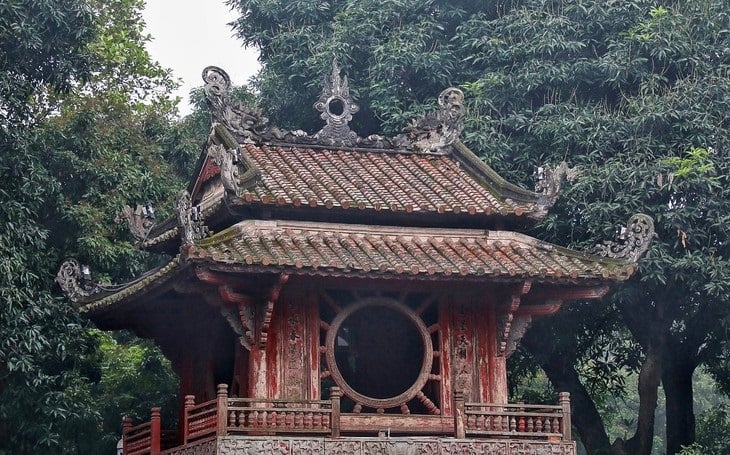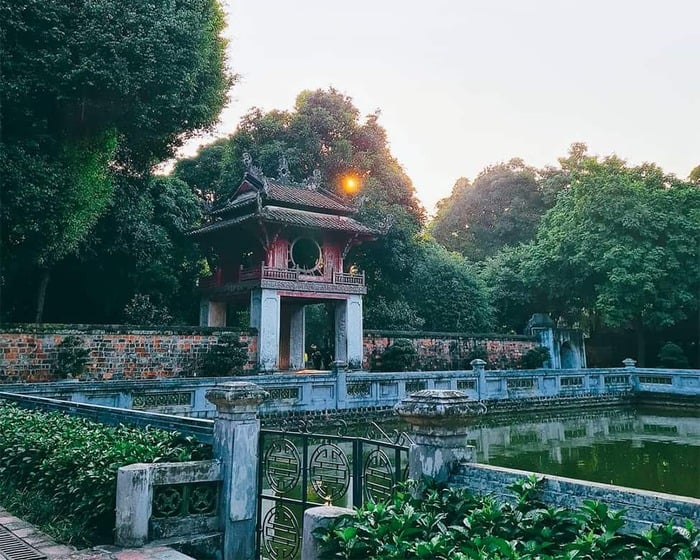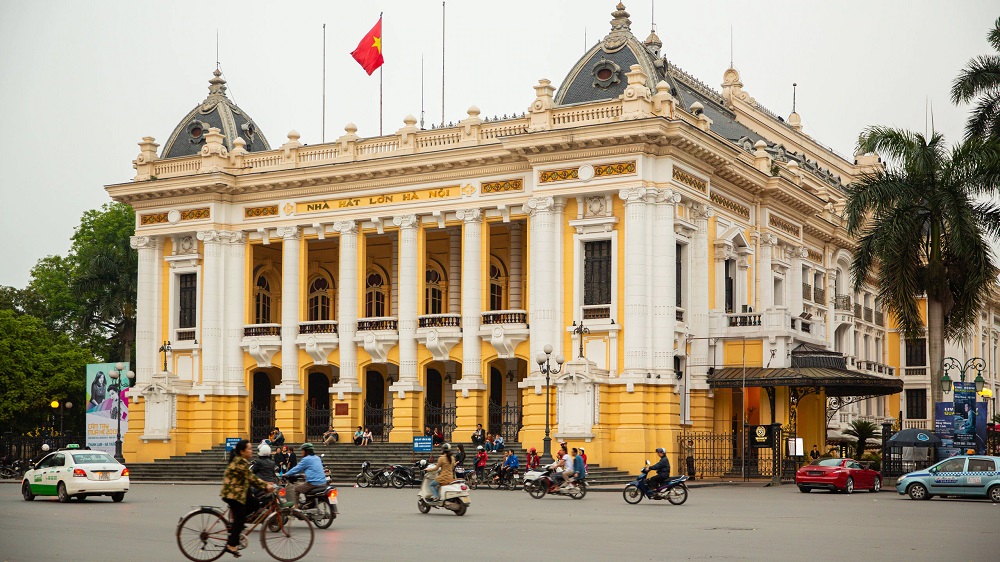
Hanoi, the vibrant capital city of Vietnam, is renowned for its rich history, culture, and iconic symbols. Among Hanoi symbols, the Khue Van Pavilion is a significant architectural gem with deep historical and cultural value. This article will delve into the captivating Hanoi symbol and other renowned cultural and historical landmarks, inviting you to embark on Hanoi travel through its unique heritage.
1. About Khue Van Pavilion - The symbol of Hanoi
1.1. Overview of Khue Van Pavilion
The Khue Van Pavilion, also known as the Pavilion of Constellation Literary, is a remarkable structure within the Temple of Literature in Hanoi. The Temple of Literature, established in 1070, was Vietnam's first national university and a center for Confucian worship and education.
1.1.1. Location of Khue Van Pavilion
The Khue Van Pavilion stands proudly in the second courtyard of the Temple of Literature (No. 58, Quoc Tu Giam Street, Van Mieu Ward, Dong Da District), surrounded by lush greenery and serene ponds. Its location within this historical complex adds to its significance as a symbol of Hanoi's intellectual and cultural legacy.

1.1.2. History of Khue Van Pavilion
The Khue Van Pavilion was constructed in 1805, long after the establishment of the Temple of Literature and the Imperial Academy. Unlike its counterparts in other countries, this Hanoi symbol is not a library but a memorial to Confucius and Confucianism.
The Hanoi symbol's location next to the Thien Quang Well holds artistic significance, with the well symbolizing the earth and the round windows on the pavilion representing the heavens. This refers to the harmonious union of yin and yang, representing balance and prosperity. In the past, scholars would gather here, seeking enlightenment from the essence of heaven and earth.

1.1.3. Architecture of the Khue Van Pavilion
The Khue Van Pavilion showcases traditional triple-gate architecture, resembling an ancient house. With a red-painted wooden top level and a double-layered tiled roof supported by sturdy wooden beams, this Hanoi symbol exudes gracefulness. Intricate carvings embellish the four square brick columns, while round windows depict the shining star, symbolizing intelligence and knowledge.
The Hanoi symbol's design features couplets in Chinese characters, highlighting the value of learning. Its architecture symbolizes the preservation of cultural heritage and represents a gateway to knowledge and success.

1.2. Why is Khue Van Pavilion Hanoi’s symbol?
The Khue Van Pavilion is considered a Hanoi symbol for several compelling reasons. Firstly, this Hanoi symbol represents a deep connection to the Vietnamese tradition of learning. As the Temple of Literature was the first university in Vietnam, the Khue Van Pavilion represents the importance of learning and the value placed on education in Hanoi's cultural fabric.
Beyond its educational significance, this Hanoi symbol's distinctive architecture, featuring wooden structures, a tiled roof, and round windows, captures the essence of Vietnamese culture. Its practical and versatile design allows for application across different mediums and architectural structures.

2. Other famous cultural and historical landmarks in Hanoi
While the Khue Van Pavilion stands as a prominent Hanoi symbol, several other landmarks contribute to the city's allure and charm. Let's explore some of these iconic sites:
2.1. Hoan Kiem Lake
Hoan Kiem Lake, located in the heart of Hanoi, is a captivating sight that compels locals and visitors alike. Its serene waters and the picturesque Ngoc Son Temple on an island in the lake make it a popular destination for relaxation and exploration.
2.2. One Pillar Pagoda - Widely considered another symbol of Hanoi
The One Pillar Pagoda, an architectural marvel, is an important Buddhist temple in Hanoi. Its unique design, with a single pillar resembling a lotus blossom, is a striking representation of Hanoi's spiritual and religious heritage.

2.3. Ho Chi Minh Mausoleum
The Ho Chi Minh Mausoleum is a solemn memorial dedicated to the revered leader of Vietnam, Ho Chi Minh. People from all walks of life pay their respects to the iconic figure who played a crucial role in shaping the nation's history.
2.4. Tran Quoc Pagoda
Situated on the picturesque West Lake, Tran Quoc Pagoda is the oldest Buddhist temple in Hanoi. Its tranquil ambiance and stunning architecture attract both locals and tourists seeking moments of serenity and spiritual reflection.
2.5. Imperial Citadel of Thang Long
The Imperial Citadel of Thang Long, recognized as a UNESCO World Heritage Site, is a testament to Hanoi's imperial past. It served as the political center of Vietnam for over a thousand years and contains remnants of ancient palaces, temples, and fortifications.

2.6. Long Bien Bridge - Among the best places to visit besides the Hanoi symbol
Long Bien Bridge, an iconic Hanoi symbol, is a historic bridge that spans the Red River. Built during the French colonial period, it offers breathtaking river views and has become a beloved spot for locals and photographers.
2.7. Hanoi Opera House
The Hanoi Opera House is a magnificent architectural gem that showcases the city's French colonial influence. It is a cultural hub that hosts various performances, including classical music, ballet, and traditional Vietnamese theater.

2.8. Hanoi Flag Tower
The Hanoi Flag Tower, located within the Imperial Citadel grounds, symbolizes the city's resilience and independence. Standing tall for centuries, it serves as a reminder of Hanoi's historical struggles and triumphs.
Besides historical landmarks, Hanoi boasts entertainment sites, including VinKE & Vinpearl Aquarium Times City. There are numerous activities for families and children, from exploring the impressive marine life to interactive exhibits.
For a thrilling adventure, head to VinWonders Ha Noi Wave Park and VinWonders Ha Noi Water Park, where you can enjoy exhilarating water slides, wave pools, and endless fun for the whole family.

>>> Book tickets to VinKE & Vinpearl Aquarium for an unforgettable journey!
If you plan to explore more of Vietnam, make sure to visit the enchanting destinations of Phu Quoc, Nha Trang, Hoi An, Da Nang, and Ha Long. These locations offer an array of breathtaking sights and cultural experiences.
To enhance your journey, it is highly recommended to indulge in the luxurious accommodations offered by Vinpearl hotels and resorts. Here, you can immerse yourself in world-class amenities, exquisite dining, and impeccable service, ensuring an unforgettable stay. Whether you are seeking relaxation on pristine beaches, exploring ancient towns, or embarking on thrilling adventures, Vinpearl hotels and resorts provide the perfect base for your exploration.


For those who want to find an entertainment paradise, don't miss the opportunity to discover VinWonders, where there are countless thrilling games and amazing shows for all ages.

>>> Book rooms in Vinpearl Phu Quoc, Vinpearl Nha Trang, Vinpearl Resort & Golf Nam Hoi An, Vinpearl Resort & Spa Ha Long for exceptional hospitality in Vietnam!
Hanoi, with its wealth of cultural and historical landmarks, proudly embraces its heritage. From the Hanoi symbol - Khue Van Pavilion, to other iconic sites like Hoan Kiem Lake, the One Pillar Pagoda, and the Ho Chi Minh Mausoleum, each landmark contributes to the tapestry of Hanoi's rich history and cultural identity. Exploring the Hanoi symbol and landmarks allows visitors to immerse themselves in the essence of Hanoi, experiencing its captivating past and vibrant present.
























